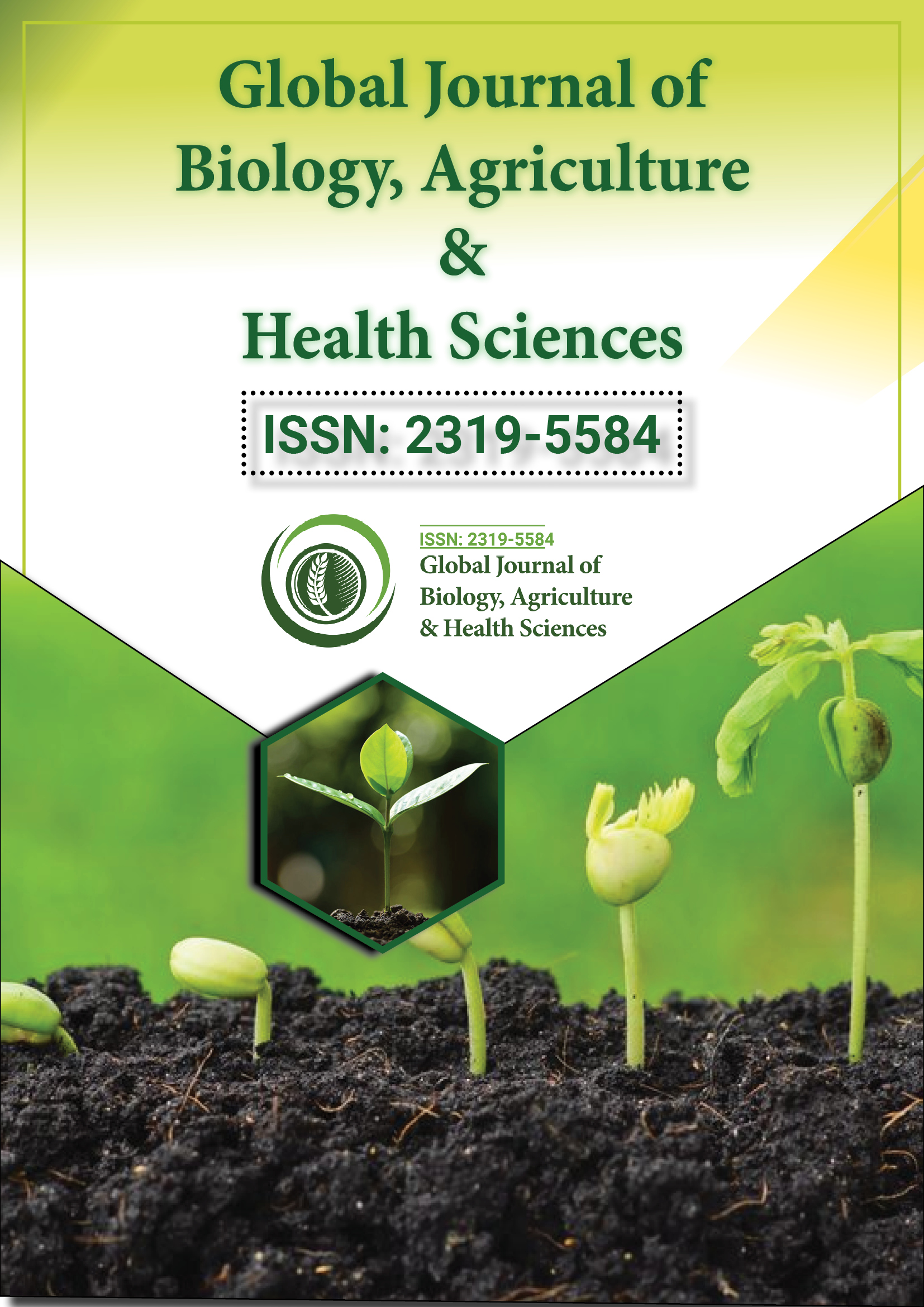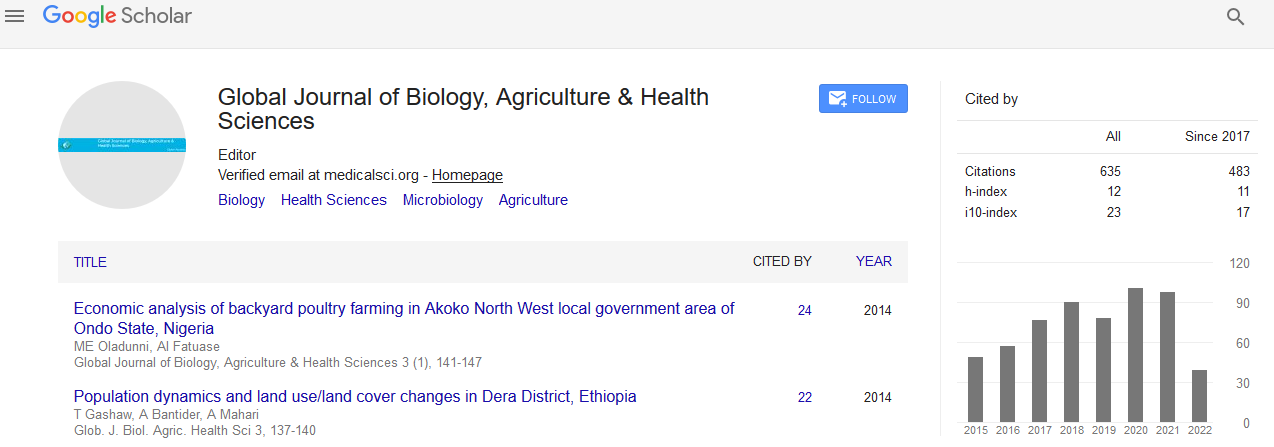Indexed In
- Euro Pub
- Google Scholar
Useful Links
Share This Page
Journal Flyer

Open Access Journals
- Agri and Aquaculture
- Biochemistry
- Bioinformatics & Systems Biology
- Business & Management
- Chemistry
- Clinical Sciences
- Engineering
- Food & Nutrition
- General Science
- Genetics & Molecular Biology
- Immunology & Microbiology
- Medical Sciences
- Neuroscience & Psychology
- Nursing & Health Care
- Pharmaceutical Sciences
Commentary - (2024) Volume 13, Issue 4
Integrating Automated Phenotyping in Crop Breeding for Better Yields
Goner Chun*Received: 27-Nov-2024, Manuscript No. GJHABS-24-28144; Editor assigned: 29-Nov-2024, Pre QC No. GJHABS-24-28144 (PQ); Reviewed: 13-Dec-2024, QC No. GJHABS-24-28144; Revised: 20-Dec-2024, Manuscript No. GJHABS-24-28144 (R); Published: 27-Dec-2024, DOI: 10.35248/2319-5584.24.13.246
Description
The rapid advancements in agricultural technology have led to significant improvements in plant breeding systems, making them more efficient and capable of meeting the growing global demand for food. One such advancement is the use of automated phenotyping in plant breeding, which enables the precise and high-throughput measurement of plant traits. This technology has revolutionized plant breeding systems by providing more accurate, consistent and scalable methods to evaluate plant characteristics, such as growth rate, disease resistance and yield potential.
Automated phenotyping involves the use of advanced sensors, imaging technologies and data analysis tools to collect and interpret plant phenotypic data. These technologies allow researchers and breeders to assess large numbers of plants in a short amount of time, providing valuable insights that can help improve crop performance. In this article, we will examine the role of automated phenotyping in plant breeding, its applications and how it is transforming plant breeding systems.
Traditionally, plant breeding involved visually inspecting plants and manually measuring traits, such as height, leaf area and disease symptoms. These methods were time-consuming and often subjective, leading to variability in results. With automated phenotyping, plant breeders can now assess a vast number of plants simultaneously with greater precision and consistency.
Automated phenotyping uses various technologies to measure and monitor plant characteristics in real-time. For example, highthroughput imaging systems, such as digital cameras, drones and hyperspectral sensors, can capture detailed images of plants from multiple angles. These images are then analyzed using advanced machine learning algorithms that can identify specific traits, such as leaf color, plant size and root structure.
One of the primary benefits of automated phenotyping is its ability to measure traits that are difficult to assess visually or manually. For example, root growth, which is critical for water and nutrient uptake, can be challenging to monitor with traditional methods. Automated systems, however, can use 3D imaging and other techniques to provide detailed data on root architecture, offering breeders valuable insights into a plant’s ability to thrive in different soil conditions.
Several technologies are integral to automated phenotyping systems. These include:
Imaging technologies, such as RGB (Red, Green, Blue) cameras, infrared cameras and multispectral imaging systems, are used to capture high-resolution images of plants. These images are processed to extract quantitative information about plant growth and development. For example, infrared cameras can detect plant water stress by measuring leaf temperature, while multispectral sensors can capture information about chlorophyll content and plant health.
High-throughput imaging systems enable the collection of large volumes of data quickly and efficiently. This allows breeders to monitor plant traits throughout the growing season, which is especially important for identifying changes in plant health or growth patterns that could indicate disease or nutrient deficiencies.
Drones equipped with cameras and sensors have become a popular tool for automated phenotyping. Drones can fly over fields and capture images of plants from various angles, providing a comprehensive view of the plant population. This is particularly useful for assessing large breeding trials, where manually inspecting every plant would be impractical.
Aerial imaging can be used to monitor crop health, growth rates and the effects of environmental conditions, such as drought or flooding. Drones can also be equipped with specific sensors to monitor soil moisture levels, plant stress and pest infestations.
Robotic systems are often used in controlled environments, such as greenhouses or growth chambers, to automate the process of plant measurement. These robots can move plants through imaging stations, take measurements and even collect samples for further analysis.
For example, robotic arms equipped with sensors can measure plant height, leaf area and other characteristics. The robots can then adjust the position of the plants for optimal imaging, ensuring consistent and accurate data collection.
Once the data is collected through imaging technologies, machine learning algorithms and data analytics tools are used to process and analyze it. These algorithms can identify patterns in the data and provide insights into plant traits that may not be immediately apparent. Machine learning models can also be trained to detect specific plant diseases, nutrient deficiencies, or signs of stress based on the data collected.
Data analytics plays a major role in automating the phenotyping process. By analyzing large datasets, breeders can gain a deeper understanding of plant traits and how they are influenced by genetic and environmental factors. This information can then be used to make more informed decisions in breeding programs.
Automated phenotyping systems have a wide range of applications in plant breeding. These applications span from accelerating the identification of desirable traits to improving the precision of breeding decisions.
One of the main advantages of automated phenotyping is its ability to accelerate the selection of desirable traits in plants. With the ability to rapidly assess a large number of plants, breeders can quickly identify those with the traits they are seeking, such as drought tolerance, disease resistance, or improved yield.
This high-throughput phenotyping process is especially valuable in breeding programs that aim to develop crops with specific traits. By automating the data collection process, breeders can evaluate multiple traits simultaneously, which significantly shortens the breeding cycle.
Citation: Chun G (2024). Integrating Automated Phenotyping in Crop Breeding for Better Yields. Glob J Agric Health Sci.13.246
Copyright: © 2024 Chun G. This is an open-access article distributed under the terms of the Creative Commons Attribution License, which permits unrestricted use, distribution, and reproduction in any medium, provided the original author and source are credited.

